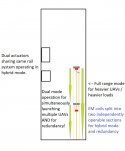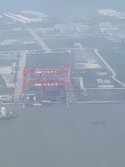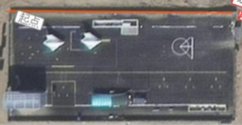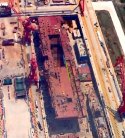You are using an out of date browser. It may not display this or other websites correctly.
You should upgrade or use an alternative browser.
You should upgrade or use an alternative browser.
Type 076 LHD/LHA discussion
- Thread starter banjex
- Start date
Why would the Chinese Navy build a ship with a catapult half the length of the ship along with all of the associated equipment that it requires, if they do intend that it be a very important part of the ships operation? This ship may well be a new class/type that has not been hitherto seen. I vote for some kind of drone mothership/carrier and I am looking forwards to this ships purpose becoming more obvious. The Chinese have a track record, culturally and historically, of being very creative and innovative and this ship looks like a prime example of this attribute in practice.You are still looking at the Catapult as the vital factor of the Type 076 when really it is a secondary determinant, troops can receive vital air support from other bases and or carriers, the specific job of the 076 is still to be an amphibious assault ship meaning it wont stray too far away from chinese shores and it’s main focus is just like any other LHA/D mentioned above. Yes of course losing a catapult would be un-preferable but that wouldn’t diminish its other capabilities as a larger and more capable upgrade to a type 075.
I personally don‘t expect the 076 to be launching and recovering drones anywhere nearly at a similar rate or amount to a carrier which means the catapult itself would be used less frequently like you mentioned about the aircraft engine, and should in theory last longer as a result. It’s probably going to be used to launch the occasional drone here and there, with VTOL and helicopters still being the main aviation branch of the ship. Unlike the Lightning UCAV carrier some others may be expecting it’s role to be.
No. We have known what this ship is intended to be, for about 4 years now.Why would the Chinese Navy build a ship with a catapult half the length of the ship along with all of the associated equipment that it requires, if they do intend that it be a very important part of the ships operation? This ship may well be a new class/type that has not been hitherto seen. I vote for some kind of drone mothership/carrier and I am looking forwards to this ships purpose becoming more obvious. The Chinese have a track record, culturally and historically, of being very creative and innovative and this ship looks like a prime example of this attribute in practice.
It is an LHD/LHA with an EMCAT. Its primary mission is amphibious assault, and the marines get their own organic CAS and ISR from drones that will be launched from the EMCAT. It will never operate alone, it will operate in an ARG likely in conjunction with a CSG (to use USN nomenclature).
Can we please stop pretending like this isn’t one of the most “telegraphed” and clearly/fully known new class of PLAN ship.
lcloo
Major
IIRC during the days when CJDBY was still active, there were already rumours that there will be a larger version of type 075, but with unknown designated type number at that time.
So the rumours for the new larger amphibious assault ship (type 076) started more than 10 years ago, before the first type 075 was built.
Too bad that CJDBY had to be closed down, may be they leaked out too much information then.
So the rumours for the new larger amphibious assault ship (type 076) started more than 10 years ago, before the first type 075 was built.
Too bad that CJDBY had to be closed down, may be they leaked out too much information then.
No. We have known what this ship is intended to be, for about 4 years now.
It is an LHD/LHA with an EMCAT. Its primary mission is amphibious assault, and the marines get their own organic CAS and ISR from drones that will be launched from the EMCAT. It will never operate alone, it will operate in an ARG likely in conjunction with a CSG (to use USN nomenclature).
This is the part that doesn't make a lot of sense. The idea that the EMCAT is integral to the primary mission of the platform ... and not secondary.
In terms of CAS for the Marines, in an amphib scenario, the offshore range that the LHD is supposed to operate at is actually quite close to shore. You're looking at most 50nm or even less - about 3nm if you have AAVs that swim to shore, maybe 10nm if you're using LCUs and/or up to 25nm if you're using LCACs to land heavy assets like AFVs, 50~100nm+ if the Type 076 is only involved in only the vertical assault, ie. helos only (light raiding force).
At these ranges, the organic rotary wing assets are quite capable of providing the necessary CAS support. Their speed and payload equals or exceeds that of most mature UCAVs platforms (ala Wing Long or MQ-9 equivalent). The only difference would be Time on Station but an amphib landing scenario is not one where you require a CAS platform with long loiter time. It's a target rich environment where you will probably expend all ordnance quite quickly and head back to mother for a quick turnaround.
And this is where it may get tricky? MQ-9/Wing Long pattern UCAVs adds a very large footprint platform that needs to be moved around hangar and deck (even with folding wings) in an already rather busy environment. CATOBAR and rotary wing ops are pretty much 2 separate sets of ATC that you have to account for on a crowded deck.
To add to that, if it (ARG) is functioning within the 1st island chain or with a CSG, then the CAS/ISR needs of the ARG are easily taken care of by land based air or the carrier wing. Fast mover jets are much more efficient at carrying ordnance than UCAVs. Your KJ-500/600 and others are also already on station and there's nothing much more a Type 076 can add to that unless it's tactical CAS and ISR, in which case, I'm looking back towards rotary wing CAS and small UAVs (whatever is the PLA equiv to the Orlan 10).
[If we're talking about using heavy UCAVs like a Sharp Sword analogue, then we're starting to cook with gas but we still haven't addressed the issue of this singular EMCAT providing a rats fart contribution in the face of the sustained sorties provided by land based/CSG air. Not going down that path unless there's compelling reason to
Likewise if we're looking at a sulf-sufficient PLANMC like a MEU/MEF, the sustained ops capability of a single EMCAT just isn't going to cut it. You're better off trying to develop a STOVL multi-role jet or upsize the Type 076 to better improve the sustained air sortie capabilities. Again, not going down this path, reason see below]
I highly doubt the single EMCAT is meant to be a significant capability enhancement for a shooting war, for reasons previously mentioned by others. (low redundancy, low sustained sortie rates, doesn't fit into the scheme of things)
Requirements dictate the platform. Once we understand the requirements, we understand why a platform is spec'ed the way it is.
There are other use cases for military assets besides an all out war. Ergo, there are other requirements that drives a platform designs beside war
A LP/LH asset is actually one of the most innately Operations-Other-Than-War capable and sought after cross use platform in the Navy. OOTW use case where the EMCAT may prove useful could be in support of the Gulf of Aden anti-piracy patrols and other possible areas where the PLAN is required to secure its SLOC. The ability to bring a MALE UAV in-theatre would expand the patrol footprint of the PLAN anti-piracy efforts quite significantly.*
So this is where I think the rather curious case of a single EMCAT on a LHD makes sense. China doesn't have military bases all over the world nor does it have excess CVs to spare to bring workhorse fixed wing assets in-theatre wherever it may require them. In this case, a LH platform masquerading as a CVL is quite a significant way to enhance the OOTW reach of the PLAN, until the day it has (and needs) a dozen CV/CVNs. Even when it does have CVs to spare, a "CVL" may still makes more sense when the requirement doesn't require a full CV - also why the USN is looking at FFGs as their DDGs get worn out trying to cover every requirement.**
* For Gulf of Aden, Djibouti is a possibility but we're looking at about 1,500nm round trip to get on station - 3,000nm if Somalia overflight is not allowed. That is a sizeable chunk out of an approx. 5,000nm endurance of a large MALE.
** For a real world case of how a LPD is used in a HADR setting, look at Operation Flying Eagle - The RSN disaster relief operations following the Tsunami of 2004. The lessons learned are also partly the reason why the follow on ship to replace the Endurance class is not like-for-like LP but a through deck LH style platform aptly called a Multi-Mission ship.
Last edited:
asif iqbal
Banned Idiot
IIRC during the days when CJDBY was still active, there were already rumours that there will be a larger version of type 075, but with unknown designated type number at that time.
So the rumours for the new larger amphibious assault ship (type 076) started more than 10 years ago, before the first type 075 was built.
Too bad that CJDBY had to be closed down, may be they leaked out too much information then.
yes to be fair to the original posters who I don’t know around 10 years ago we had full bunch of information
even we heard of two gigantic cutters at 12,000 tons and that was true also
the Type 055 and Type 075 and 076
and even the carrier programs were leaked
It was a good time and we are lucky to have seen it materialize
I wish we had another such leak for the next 10 years
Have you guys noticed how long the EM rail slot is considering it's most likely used for launching UAVs? I heard a lot of back and forth regarding redundancy and purpose served by this ONE EMALS. Well I'm pretty sure the designers, engineers and planners are pretty well aware of such potential issue and are either quite sure of its reliability or they may not considered it an issue for its planned usage. Having said that, has anyone considered the possibility that this may not be in fact, ONE EMALS but TWO EMALS stacked back to back running on the same rail with two separate sections of acceleration coils, thus solving the issue of redundancy if such is deemed necessary by PLAN?? This would also allows for more flexibility of aircraft launch catering to both sortie rate as well as heavier payloads which also explains why the EMALS took up half the length of the deck.
I've indicated in the illustration below what I meant by dual actuators operating on the same rail with primary and potential secondary reset position of the launch actuator(s). Even in full range acceleration mode, the forward actuator does not need to be reset while the aft actuator can immediately launch a second aircraft provided that the EM rail can recover and recharged in time thereby improving on sortie rate for heavy UAVs as well.

I've indicated in the illustration below what I meant by dual actuators operating on the same rail with primary and potential secondary reset position of the launch actuator(s). Even in full range acceleration mode, the forward actuator does not need to be reset while the aft actuator can immediately launch a second aircraft provided that the EM rail can recover and recharged in time thereby improving on sortie rate for heavy UAVs as well.

I find your hypothesis to be highly unlikely due to the information we already have.Have you guys noticed how long the EM rail slot is considering it's most likely used for launching UAVs? I heard a lot of back and forth regarding redundancy and purpose served by this ONE EMALS. Well I'm pretty sure the designers, engineers and planners are pretty well aware of such potential issue and are either quite sure of its reliability or they may not considered it an issue for its planned usage. Having said that, has anyone considered the possibility that this may not be in fact, ONE EMALS but TWO EMALS stacked back to back running on the same rail with two separate sections of acceleration coils, thus solving the issue of redundancy if such is deemed necessary by PLAN?? This would also allows for more flexibility of aircraft launch catering to both sortie rate as well as heavier payloads which also explains why the EMALS took up half the length of the deck.
I've indicated in the illustration below what I meant by dual actuators operating on the same rail with primary and potential secondary reset position of the launch actuator(s). Even in full range acceleration mode, the forward actuator does not need to be reset while the aft actuator can immediately launch a second aircraft provided that the EM rail can recover and recharged in time thereby improving on sortie rate for heavy UAVs as well.
View attachment 132653
Based on the current structure seen from the ship itself there is no room for another jet blast deflector as it is slightly wider than the gap needed for the installed catapult, and from the land based testing area, we can clearly see that they are not testing any drones to take off midway from what we can see. Of course you can speculate all you want but this kind of speculation is pretty unrealistic. And I don't see much redundancy in a catapult where they are stacked right in front of each other.




